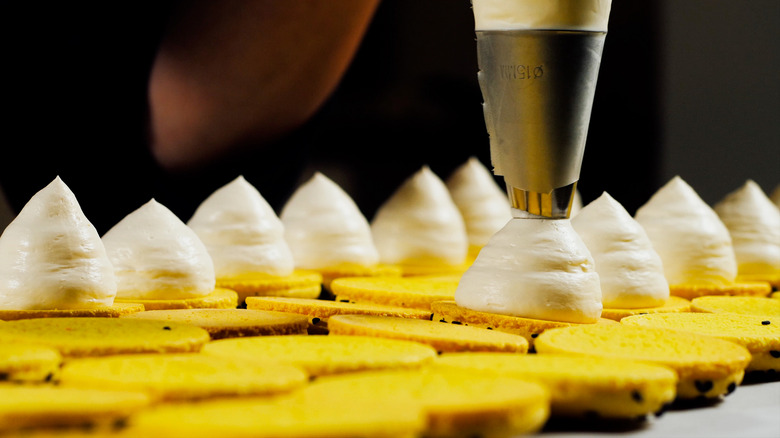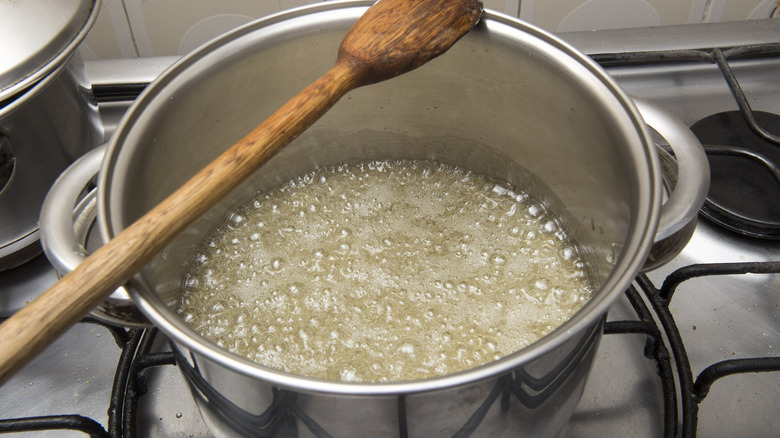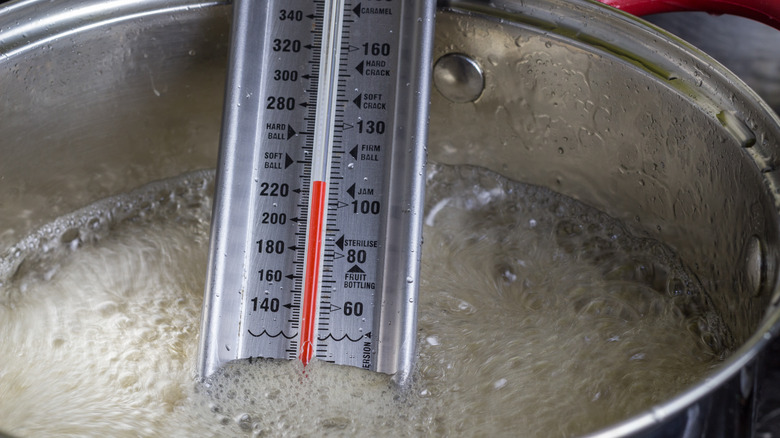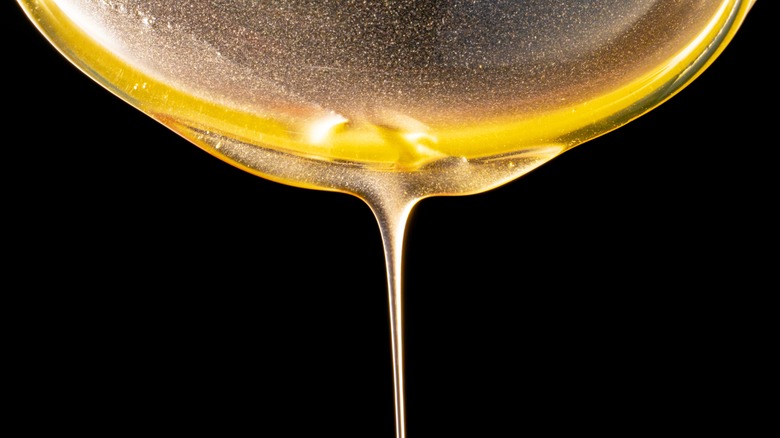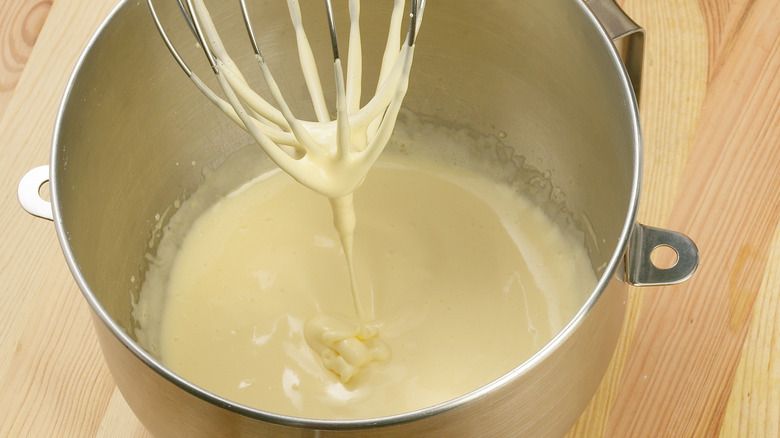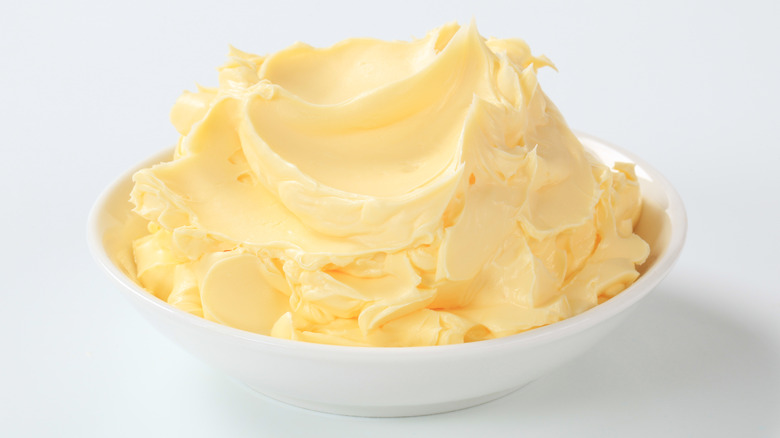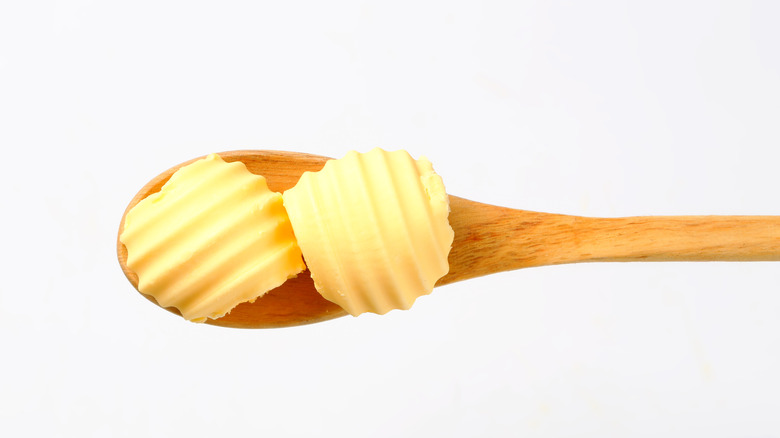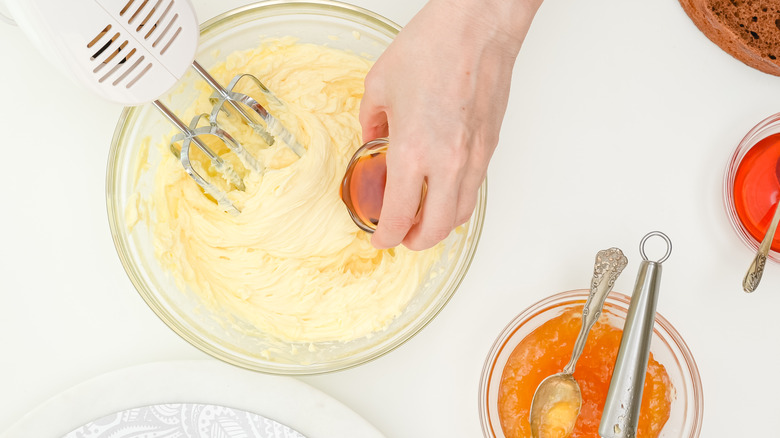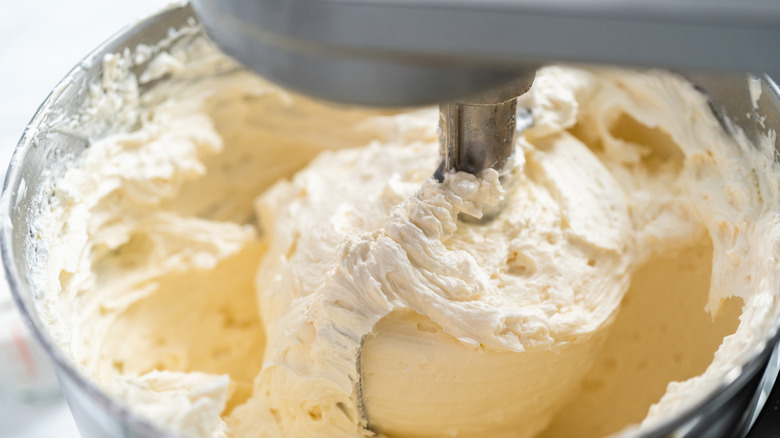8 Tips To Master French Buttercream
If you're an avid baker, you've probably come across meringue-based buttercreams. But another buttercream, though less well known, is just as tasty and versatile. Referred to as the cousin of Italian and Swiss buttercreams, French buttercream is a luxurious frosting sweetened with cooked sugar syrup, thickened with egg yolks, and enriched with soft butter.
It's an underrated frosting, partly because it's more expensive and less practical to make, requiring egg yolks instead of egg whites. But yolks are what give French buttercream its unique, silky, custard-like texture that's a dream to pipe and use in various pastries, including fruit tarts, cakes, macarons, and cupcakes. Its off-white hue and tendency to melt in warmer environments are considered drawbacks by some bakers, but it's worth knowing how to make it so you can supplement your frosting arsenal. You'll be glad you did, especially when you've got a container of leftover egg yolks after making angel food cake or meringues.
French buttercream is totally makeable, regardless of your culinary expertise. Still, timing and focus are critical as things can go awry at every step, from cooking the sugar, to heating the egg yolks, and adding the butter. So, I'm sharing some pointers ─ learned from many years of working in pastry kitchens and writing cookbooks ─ to help you master this classic buttercream. Whether you're a baking newbie or just need a refresher, these tips will help you avoid any unexpected buttercream mishaps.
1. Use a clean pot to cook the sugar syrup
French buttercream starts with combining granulated sugar and water in a pot on the stovetop. As the mixture is heated, the sugar dissolves and thickens into a smooth syrup. While this may sound simple enough, a problem can quickly show up if you don't take a few minutes in the beginning to inspect your pot. When cooking the sugar syrup, your pot must be completely clean, because any traces of impurities will cause the formation of crystals. So, before starting, take a minute to make sure your pot is free of any residue, and if in doubt, err on the side of caution and wash it again to be sure.
Once the sugar syrup begins to boil, avoid stirring it and allow it to cook, letting the heat do the work. Any agitation can introduce impurities directly from your spoon or spatula, or from splashing onto the sides, which, as the water evaporates, will leave sugar to crystallize and fall back into the mixture. Ultimately, this will make your buttercream grainy, making for an unpleasant appearance and less-than-ideal eating experience.
2. Cook the sugar syrup to the right temperature
Cooking the sugar syrup to the right temperature is important for enabling your buttercream to come together correctly. As the sugar syrup cooks, the water boils off, the sugar concentration increases, and the temperature rises. The ideal temperature is between 235-240 degrees Fahrenheit ─ the soft ball stage (more on that below). I've found that reaching this temperature can take around 10 minutes, so be patient. If you don't allow the sugar syrup to cook long enough, your buttercream will end up being runny. On the other hand, if you overcook the sugar syrup, your buttercream will be too firm, and you also risk caramelizing the syrup.
Knowing when to stop cooking your sugar syrup can be tricky, so using a thermometer is best. Attaching a candy thermometer to your pot will make determining when to remove the sugar syrup from the heat easier and less stressful. While not a required tool, a candy thermometer will remove much of the guesswork.
If you don't have a candy thermometer, your best alternative is to perform what's known as the cold water test. Drop a small amount of the sugar syrup into a glass of cold water. If the sugar syrup has reached the aforementioned soft ball stage, it will form a soft, flexible ball that, when removed from the water, will flatten like a pancake in the palm of your hand after a few seconds.
3. Add the sugar syrup to the egg yolks in a slow, steady stream
While the sugar syrup cooks, begin whisking your egg yolks in an electric mixing bowl until they're thick and light yellow in color. When the sugar syrup is ready, immediately pour it into the beaten yolks in a thin, steady stream with the mixer running at low speed. Make sure to pour continuously — but gradually — into the gap between the whisk and the sides of the bowl so the syrup doesn't splash onto the sides. If that happens, the sugar syrup will harden upon hitting the cold sides of the bowl.
Be aware of the speed at which you add the hot sugar syrup. Adding too much hot sugar syrup at once will deflate the beaten yolks; while you won't ever achieve the airiness of meringue-based Italian or Swiss buttercream, you want to retain as much lift as possible. Pouring in the hot sugar syrup too quickly may also cause the egg yolks to scramble, and you'll have to start over.
4. Cool down the sugar-yolk mixture sufficiently
After adding all the hot sugar syrup to the egg yolks, increase your mixer's speed to high to begin cooling down the mixture and incorporating air. Continue whipping until the outside of the mixing bowl is cool. Take your time with this part, as the egg yolk mixture must be cool enough to move on to the next step of adding the butter. If the yolk mixture is too warm when the butter is added, the butter will melt and your buttercream will turn soupy.
To test whether the mixture has cooled sufficiently, press the underside of your forearm against the bottom of the mixing bowl; it should feel cool or at least room temperature. If unsure, it's best to play it safe and whip it a few more minutes. Beating the egg yolk mixture a little longer, even if sufficiently cooled, won't be detrimental. If you add butter to the egg yolk mixture and it appears to melt, stop adding more butter and place the mixing bowl in the refrigerator for 5 to 10 minutes before whipping it again.
5. Use butter that is soft and pliable
For the smoothest French buttercream, your butter must be the right consistency — not too cold or warm, but just right. If your butter is too cold when added to the egg yolk mixture, you'll end up with clumps of butter, making your buttercream unpalatable and difficult to spread or pipe. If your butter is too warm, it won't get incorporated into the yolk mixture properly and will break down, causing the buttercream to curdle. Check that your butter is soft, pliable, and not the least bit greasy, liquid, or melted. When you press into the butter, it should yield with just a bit of pressure, and if you want to be even more certain, use a thermometer to check that the temperature is about 70 degrees Fahrenheit.
The best way to prep your butter for French buttercream is to leave it on the counter for 30 to 60 minutes before using it. Or, if you don't mind getting your hands a little messy, work the butter with your fingers, squeezing it to warm until it reaches the right consistency. You can also soften butter quickly by rolling it out with a rolling pin. Place the butter between two sheets of wax paper, roll it to between ¼-inch and ⅛-inch thick, then peel it off the paper to use.
6. Add butter a little at a time
Incorporate the butter into the yolk mixture slowly and methodically. With the mixer running on medium speed, add the butter 1 to 2 tablespoons at a time, and allow each portion of butter to fully incorporate into the yolk mixture before adding the next batch. You can separate out small portions of butter with a spoon or your fingers, or if you pre-cut the butter into small pieces ahead of time, even better. Adding the butter slowly — and in small portions — allows the emulsion of fat and liquid to form.
If the mixture starts to resemble curdled milk, your buttercream is too cold. A quick fix is to use a kitchen torch to gently heat the outside of the mixing bowl, with the mixer running until the buttercream starts to come together. Or, you can place the mixing bowl over a double boiler while gently agitating the buttercream to warm it slightly before mixing again. Alternatively, if the mixture looks greasy or soupy, your buttercream is too warm. Don't panic; all is not lost. Place the mixing bowl in the refrigerator for 10 minutes to chill the buttercream. Then try again, whipping the buttercream until it comes together.
7. Add flavorings to the finished buttercream
French buttercream is excellent for flavoring. Its high-fat content from egg yolks and butter makes it an excellent flavor carrier. You can flavor the whole batch, or portion it out and make several different flavored buttercreams. Why have one flavor of buttercream when you can have many? Your imagination is the only limit to the flavors you can make with French buttercream.
As we all know, vanilla extract can transform a buttercream with just a teaspoon or two; vanilla bean paste is even better. Any extract — like coffee, orange, and almond — will add a boost of flavor for different uses. We're big fans of freeze-dried fruit, ground into a powder and folded into buttercream. Fruit jams, purées, and curds can turn your buttercream into a light, flavorful frosting for summer desserts like strawberry cake and lemon tarts. If you're after boozy, rum and brandy are classic choices. Consider adding instant coffee for some oomph, or some melted chocolate for some decadence. Finally, spices, like cinnamon, nutmeg, and cloves, add depth and warmth to buttercream, a perfect companion for fall desserts like carrot cake and pumpkin cupcakes.
8. Store buttercream properly
French buttercream is great for making ahead, especially if you're creating a tiered cake or a multitude of pastries that require a lot of additional time and planning. You can store your finished buttercream in an airtight container in the refrigerator for up to one week, but bringing the chilled buttercream up to room temperature is essential before you use it. You'll need to factor in a couple of extra hours to allow the buttercream to soften on the counter at room temperature. If you skip this step and try to beat your buttercream while cold, the emulsion will break, and the fat and liquids will separate.
You can also keep French buttercream in the freezer for longer storage, where it will stay good for two to three months. When you know when you'll want to use the buttercream, transfer it to the refrigerator the day before you need it. This will allow the buttercream to defrost slowly, minimizing any temperature shock. After the overnight thaw in the refrigerator, transfer the buttercream to your counter, and bring it to room temperature to soften before beating it for use.
